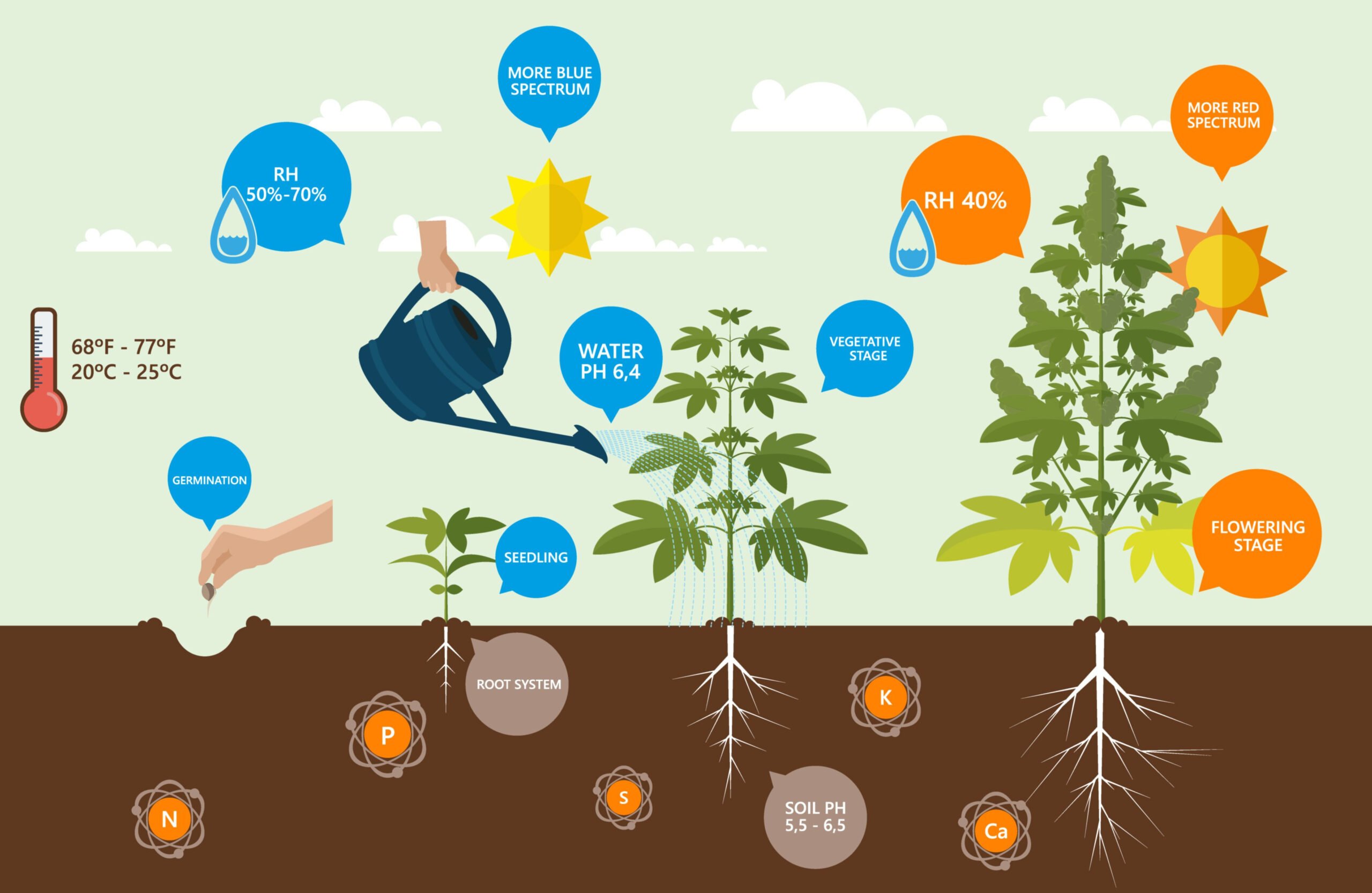Table of Contents

You want to give your cannabis plants everything that they need to thrive, but it can be tough to figure out the right schedule for feeding your plants nutrients. Here, we’ll take a look at everything you need to know about giving your plants the exact nutrients they need to grow and thrive.
We all know the basics of what plants need to grow–light, carbon dioxide, and water–but plants sometimes also need a supplement of nutrients in addition to what their roots are able to pull from the soil.
When growing cannabis, you’ll need to consider the specific needs of your plants to decide what nutrients are necessary for optimal growth. You’ll also need to consider the size of your plants, as well as their age.
Starting with the right soil is a smart way to help your cannabis plants get off to a healthy start. Research the type of soil that’s best for your cannabis plant strain, but don’t be surprised if you find that you need to make some changes along the way.
If you decide that you need to switch your plants over to a new soil, it’s smart to wait until it’s time to transplant. This can help your plant adjust, as the old soil will still be attached to the roots, allowing the roots to ease into their new home.
If your plants are struggling with drainage and you want to add some new components to the soil, you may want to think about adding perlite (so that it makes up about 30% of the soil) and vermiculite (so that it makes up about 10% of the soil), as these can help improve drainage and help your plants get the oxygen that they need to grow.
Your TDS stands for total dissolved solids, and as you begin to research how to feed your cannabis plants, you’ll likely come across this term often. Your TDS can give you an idea of how many nutrients and minerals are in your watering solution, but won’t tell you the actual makeup of the nutrients. While TDS can be a helpful number to help you see whether you’re headed in the right direction, you won’t want to rely on TDS alone to give you an idea of whether your plants are getting all that they need.
While following a feeding schedule for your cannabis plants is smart, you’ll also need to keep an eye on them to determine whether your schedule needs adjustment. It can take some time to get to know your plants and figure out exactly what they need to thrive.
When you’re ready to transplant your seedlings into a larger home, that means you’ve entered the vegetative stage. During this stage of growth, it’s smart to use store-bought soil to ensure that your plants are getting off to the right start.
You’ll want to choose soil that has solid water drainage and retention properties, and you’ll also want to keep an eye on the pH level of the soil you choose. You’ll want to shoot to maintain a pH of 6.0 to 6.5 for optimal growth.
Instead of choosing a soil mix that’s heavily fertilized, you’ll want to manually add nutrients so that you stay in control of giving your plants what they need. In this stage, you’ll want to focus on giving your seedlings the light they need to begin to grow.
During weeks one and two, keep your plants about three and a half feet away from your grow lamps. You’ll also want to only use half of your lamps during this phase, while still giving your plants about 18 hours of light per day. During the second week of the vegetative phase, it will be time to use a fertilizer high in nitrogen to ensure that your plants are getting enough of the crucial growth nutrient.
During the third week of growth, your plants will begin to enter the flowering stage. At the start of week three, it will be time to change your light schedule to 12 hours on, 12 hours off, while using half of the lights. You’ll want to move your plants a bit closer to the lights, about a foot and a half away. Your plants are still heavily in the growing phase at this point, so you’ll want to continue to provide them with the nutrient mix that helped them get through weeks one and two.
You’ll also want to begin giving your plants more water during this phase. Keep the humidity in the room around 60%. During week four, you’ll notice that your plants go through a major growth spurt, and you’ll want to ensure that they stay at least a foot and a half away from your grow lights, even as they begin to expand.
When week four comes to an end, you’ll want to rinse the soil with water at a pH of 6.5.
As you move into the fifth week of growth, you’ll begin to see flower development. At this point, you’ll need to make the switch to a high-phosphorus fertilizer to support growth. In the sixth week of growth, your’ll continue with the high-phosphorus fertilizer, and you’ll also want to ensure that you keep an eye out for any bugs on your plants.
During this phase, you’ll notice that buds begin to grow. You’ll want to flush your soil with water (with a pH of 6.5) at the end of week seven. At the end of week eight, it’s smart to boost the potassium levels of your soil by using a fortified fertilizer. Adding more potassium will help your plant’s buds begin to ripen.
At this point, in addition to keeping an eye out for bugs, you’ll also need to watch for mold.
At this point, you’re getting ready to harvest, and you’ll need to switch up how you’re feeding your plants in order to make sure they’re ready. At the start of week nine, flush the soil, and then feed your plants their nutrient mix at a lower concentration than normal. You may find that the leaves on your plant are starting to die, but fear not–this is normal and to be expected. A few days prior to harvest, stop fertilizer altogether, and just provide your plants with clean water.
Remember, keep an eye on your plants to learn what they need, and depend on their cues more than a schedule to figure out how to keep them growing healthy and strong.

Curious about growing weed in a healthy, effective way? Welcome to the realm of weed hydro! This method uses water instead of soil, delivering n

Peyote Zkittlez is a unique cannabis strain that has quickly gained dedicated followers among enthusiasts and patients alike. Its parentage—Zk

As growers, we want strains that work well, are strong, and are of good quality. Autoflowering cannabis strains are a big step forward for both

Pot growers always ask the same basic question: How much weed does a weed plant produce? The answer is complex and depends on a multitude of var

Ever had the room spin after a few hits? You're not alone. Figuring out how to prevent getting dizzy high can make your cannabis experience a wh

Drying cannabis properly is a critical process in preserving the plant's full aroma and flavor and its psychoactive abilities. Tampering with th

Ever caught yourself a bit too high and all of a sudden in need of being normal? Whether you're heading out for munchies or bumping into someone

Looking for sage advice on how not to get pinched with weed without batting an eye? Attempting to protect your stash from gossipy roommates, sno

Nutrient lockout, also known as nutrient binding or chemical antagonism, is a significant issue in cannabis cultivation that negatively impacts

Germination is the most critical initial stage in growing healthy, high-quality cannabis plants. During germination, the dormant seed becomes a
Are You 18 Or Over?
By selecting “Continue”, you confirm that you are at least 18 years of age and legally permitted to access cannabis related content in your region.
By using Rocketseeds.com, you agree to our legal disclaimer.
Excellent blog here Also your website loads up very fast What web host are you using Can I get your affiliate link to your host I wish my web site loaded up as quickly as yours lol
Your writing is not only informative but also incredibly inspiring. You have a knack for sparking curiosity and encouraging critical thinking. Thank you for being such a positive influence!
Simply wish to say your article is as amazing The clearness in your post is just nice and i could assume youre an expert on this subject Well with your permission let me to grab your feed to keep updated with forthcoming post Thanks a million and please carry on the gratifying work
Somebody essentially lend a hand to make significantly articles Id state That is the very first time I frequented your website page and up to now I surprised with the research you made to make this actual submit amazing Wonderful task
Your blog is a beacon of light in the often murky waters of online content. Your thoughtful analysis and insightful commentary never fail to leave a lasting impression. Keep up the amazing work!
Thank you for the auspicious writeup It in fact was a amusement account it Look advanced to more added agreeable from you By the way how could we communicate
Your blog is a constant source of inspiration for me. Your passion for your subject matter shines through in every post, and it’s clear that you genuinely care about making a positive impact on your readers.
Your blog is a constant source of inspiration for me. Your passion for your subject matter is palpable, and it’s clear that you pour your heart and soul into every post. Keep up the incredible work!
Your articles never fail to captivate me. Each one is a testament to your expertise and dedication to your craft. Thank you for sharing your wisdom with the world.
Your blog is a testament to your dedication to your craft. Your commitment to excellence is evident in every aspect of your writing. Thank you for being such a positive influence in the online community.
Your writing has a way of resonating with me on a deep level. I appreciate the honesty and authenticity you bring to every post. Thank you for sharing your journey with us.
Your blog is a true gem in the world of online content. I’m continually impressed by the depth of your research and the clarity of your writing. Thank you for sharing your wisdom with us.
Hi i think that i saw you visited my web site thus i came to Return the favore Im attempting to find things to enhance my siteI suppose its ok to use a few of your ideas
Somebody essentially help to make significantly articles Id state This is the first time I frequented your web page and up to now I surprised with the research you made to make this actual post incredible Fantastic job
Usually I do not read article on blogs however I would like to say that this writeup very compelled me to take a look at and do so Your writing taste has been amazed me Thanks quite nice post
Your blog has quickly become one of my favorites. Your writing is both insightful and thought-provoking, and I always come away from your posts feeling inspired. Keep up the phenomenal work!
Every time I visit your website, I’m greeted with thought-provoking content and impeccable writing. You truly have a gift for articulating complex ideas in a clear and engaging manner.
Hey there You have done a fantastic job I will certainly digg it and personally recommend to my friends Im confident theyll be benefited from this site
I have read some excellent stuff here Definitely value bookmarking for revisiting I wonder how much effort you put to make the sort of excellent informative website
Nice blog here Also your site loads up very fast What host are you using Can I get your affiliate link to your host I wish my site loaded up as quickly as yours lol
What i do not understood is in truth how you are not actually a lot more smartlyliked than you may be now You are very intelligent You realize therefore significantly in the case of this topic produced me individually imagine it from numerous numerous angles Its like men and women dont seem to be fascinated until it is one thing to do with Woman gaga Your own stuffs nice All the time care for it up
Your blog is a beacon of light in the often murky waters of online content. Your thoughtful analysis and insightful commentary never fail to leave a lasting impression. Keep up the amazing work!
Your blog is a breath of fresh air in the often stagnant world of online content. Your thoughtful analysis and insightful commentary never fail to leave a lasting impression. Thank you for sharing your wisdom with us.
Your blog is a beacon of light in the often murky waters of online content. Your thoughtful analysis and insightful commentary never fail to leave a lasting impression. Keep up the amazing work!
Usually I do not read article on blogs however I would like to say that this writeup very compelled me to take a look at and do it Your writing style has been amazed me Thank you very nice article
Your writing has a way of resonating with me on a deep level. I appreciate the honesty and authenticity you bring to every post. Thank you for sharing your journey with us.
This hydroponics guide is quite the buzz, seriously! Who knew growing weed without dirt could be so complicated yet potentially rewarding? The breakdown of systems like DWC and NFT is helpful, though I suspect my cat might confuse the air pump for a toy. The idea of cleaner buds is tempting, especially since explaining hydro weed to my non-growing friends might get messy. And the bit about potential dizziness from hydro weed? Perfect, now I have an excuse for why I always stumble a bit after a grow session. Still, the promise of faster grows and higher yields is hard to ignore, even if it means more trips to the pH meter than to the coffee shop. Overall, a cultivating read for the curious grower!